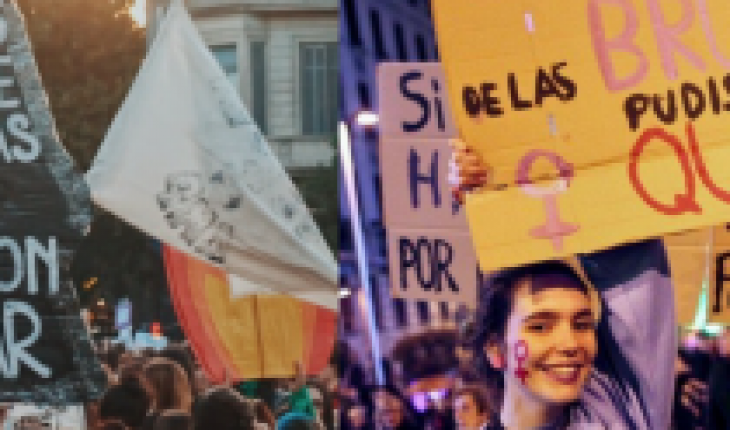This October marks the month of witches, a figure openly demonized and persecuted throughout human history. According to cartoons and children’s literature, these are usually vile, ugly, wrinkled, old and single women whose purpose is to destroy the happiness of other people, especially an innocent, beautiful and delicate princess.
However, this conception of witchcraft could not be further from reality, since, witches were the first women in leaving the domestic area to which women have historically been relegated and they dared to venture into what would be the first attempts at medicinal practices, chemistry and even in the studies of botany.
It was not until the year 1400 that this figure began to be widely demonized by the Catholic Church, a fact that unleashed one of the crudest mass murders in history, since it is estimated that between the fifteenth and seventeenth centuries in Europe and America more than 60,000 people were executed, among them, mainly women who were accused of practicing witchcraft.
According to the tarotist, witch by lifestyle and administrator of the Instagram account ‘Bruja Boreal’, Karen Esparza, as in those times the woman had no right to study and there was no accepted scientific support for her discoveries, “these were persecuted and called witches only for healing a stomach ache, which at that time could mean that a person was demonized”.
At that time, the Catholic faith reigned in the West, cities were built around the figure of the churches and, consequently, anyone who threatened the institution of Catholicism as the highest authority was tortured, hanged, burned alive or forced to perform tasks impossible to achieve humanly speaking.
However, what the church considered witchcraft encompassed a wide range of knowledge related to the sciences or any practice that was outside the norm. An example of this was the collection of medicinal plants, the use of which was forbidden unless their efficacy was explicitly recognized by the church as a manifestation of divine power.
According to the practitioner of witchcraft and tiktoker with more than 380 thousand followers, Maria Godoy, better known on social networks as Milkybaae, “any kind of woman who knew a little medicine or the handling of plants was considered a witch for the sole fact that women were believed to be unable to be intelligent and do what a man couldn’t. Therefore, a woman who knew about herbalism, nature, home remedies, astrology and who knew more than was supposed, was considered a witch. (…) When in reality witches are the ones who practice understand the energies and know how to use them to their advantage.”
This is how the church eradicated a whole generation of women with extensive knowledge in various practices, making invisible all the scientific contributions they made during the period of the Inquisition.
Credits: Freepik
The relationship between witchcraft and feminism
Since the beginning of time, feminism and witchcraft have had a relationship with respect to the historical oppression that women have experienced, since, although this is a practice alien to gender, since it is a discipline for both men and women, they have that historical burden for having been the first women who faced men in history, to defend themselves against repression, continuing their practices in hiding.
Along the same lines, witches always advocated the same values that feminists advocate, for example, physical self-knowledge and freedom, so the theme of abortion went hand in hand with work in medicine and herbalism.
“Witchcraft and feminism are connected in a not so linear way, it was not that at some point they said ‘we are going to be the granddaughters of witches who could not burn’, but it is related to the oppression we have lived (…) That is why witches also helped other women who did not want to be mothers through medicines with plants, there are various types of plants that can help us abort and that at that time they used to avoid getting pregnant. Nowadays there are perhaps many fewer who use them to abort or prevent pregnancies, but they are knowledge that will passI walk through the different types of era,” says Esparza.
For the expert, this practice serves a lot to “empower us and stop being our own enemies, because when you get the period at age 12, you hate your uterus, you hate being a woman and you hate all that ‘divine punishment’ that life gives you. However, from witchcraft, you learn not to see it as a punishment since it gives you self-knowledge through your own emotional states. I find it wonderful.”
It is thanks to this type of knowledge that on many occasions witches were nicknamed the “first feminists in history”. Regarding this, the administrator of Bruja Boreal assures that “to be a witch you have to be a feminist and to be a feminist it is also necessary to understand the pain of other sisters who lived in other times and who suffered and were persecuted just for the fact of being women.”
On the other hand, for the young tiktoker, “although it is not a requirement to be a feminist to be a witch, it is very common to understand that relationship between the two. Since witchcraft is related to women’s empowerment and sisterhood, this practice makes you understand yourself, makes you aware of your emotions, what surrounds you, and the power over yourself.”
The vindication of witchcraft in the feminist struggle
At present, many young women belonging to the feminist movement have vindicated the invisible history of witches who were persecuted and killed for being different and lately, the figure of the witch has been used as a feminist symbol in social protests.
“That today they take in reference as a feminist icon to witches I find it wonderful, because also in itself witches as practitioners outside what society was we find the answer in an environment that was also very oppressed by men, but this shows that today we manage to take for ourselves,” says Esparza.
Currently, witchcraft is still a fairly stigmatized practice and as it used to be done in the past, it is usually practiced secretly from the public light. However, it is increasingly common to see young people learning astrology and other ancestral knowledge that they claim.
María explains that, although her practice is done in a solitary way, there have been occasions in which she has joined other women to make spells for common causes, as was the case in the case of the trial of Martín Pradenas, when they joined together to make a candle to manifest good energies on behalf of Antonia Barra and her family. On another occasion they performed a spell with negative energy on Pradenas to send him karma for his actions. “The next day he was remanded in custody,” he says.
“We are the granddaughters of witches who could not burn”: the feminist vindication of witchcraft
October 14, 2021 |





